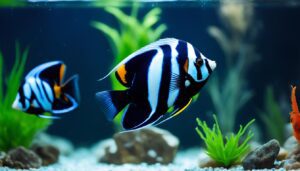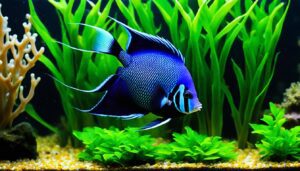Welcome to an exciting story about the Half-Black Angelfish, a standout in the aquarium world. Known for its striking looks and engaging behavior, it’s a top pick among fish fans. Caring for this fish is a fulfilling journey that celebrates the beauty of marine life.
This fish calls the tranquil rivers of South America home, mainly the Amazon basin. It brings a slice of the Amazon’s vivid environment to our tanks. They flourish in surroundings that mimic their natural abode, requiring careful attention and knowledge of their preferences.
To start this aquatic journey, your tank should hold at least 114 liters (30 US gallons). This size supports the Half-Black Angelfish’s unique behaviors and graceful swimming. A balanced community tank is essential for these South American natives. If you’re keen to make your fish tank a welcoming place for the Half-Black Angelfish, let’s explore the key info on their care and tank setup.
Unveiling the Half-Black Angelfish: A Natural Marvel
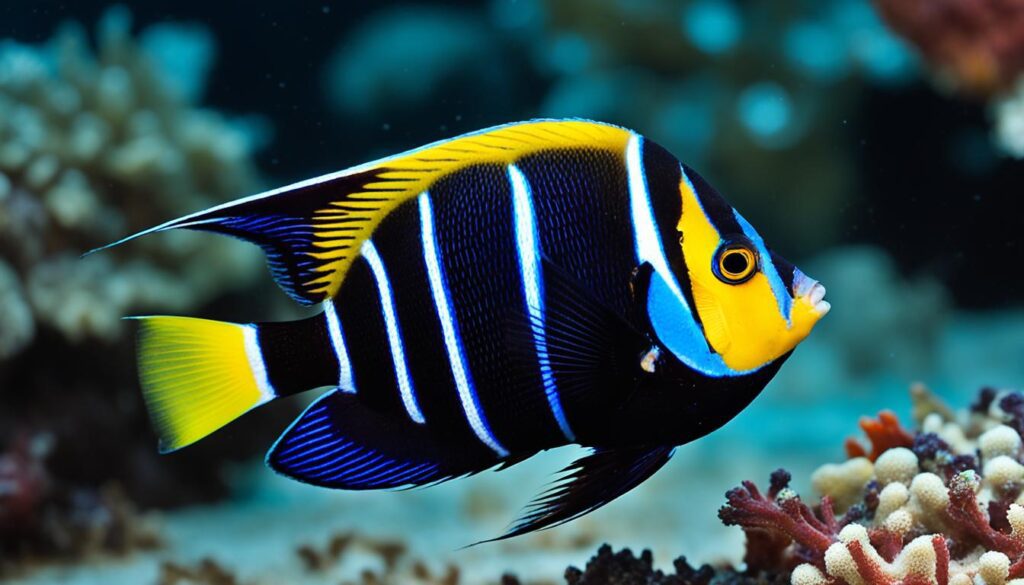
The Half-Black Angelfish has won the hearts of fish lovers everywhere. It’s a perfect example of selective breeding. Its unique look and patterns show what breeders can do. This fish isn’t just pretty to look at. It’s a sign of what humans can achieve with patience and science.
The Birth of the Half-Black Angelfish: Selective Breeding Mastery
Selective breeding lets us bring out special features in fresh water angelfish. The Half-Black Angelfish came to be this way. Its rare coloring, with a black back and a shiny front, is very sought after. It’s a big deal in the world of fish tanks.
Discovering the Half-Black Angelfish: Rarity and Popularity in Aquariums
The Half-Black Angelfish is special because it’s hard to find. This makes it very valuable to fish tank fans. It’s put in a special spot in aquariums all over. The chase for such rare fish makes us all more interested in protecting underwater life.
The Native Waters: Understanding Their South American Roots
The Half-Black Angelfish comes from the Amazon basin habitat. Here, it lives in calm waters with lots of greenery. Fish tanks at home try to mimic this. It helps keep the fish healthy and bright.
The growing interest in fish tanks helps both selective breeding and mother nature. It’s important to keep our practices green. This makes sure the Amazon’s beauty and its fish can be enjoyed everywhere.
Creating the Ideal Habitat: Tank Requirements for Half-Black Angelfish
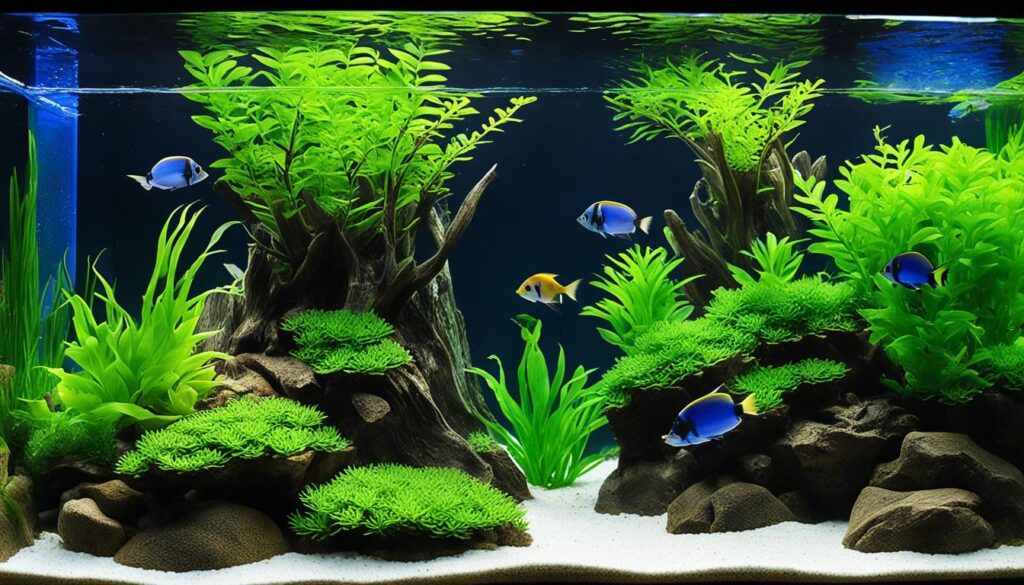
To create the best home for Half-Black Angelfish, it’s crucial to make their tank resemble their natural habitat. This includes focusing on angelfish tank setup, like space, water quality, and keeping the water at the right temperature. Doing this helps these beautiful fish stay healthy and happy in a community aquarium.
Size Matters: Minimum Tank Size for Their Comfort
Experts recommend a 70-gallon tank as the minimum to keep Half-Black Angelfish comfortable. This size lets them swim freely and act like they would in the wild. If you want more than one, think about getting a 150-gallon tank. A bigger tank reduces fighting and gives each fish its own space in the community aquarium.
Water Parameters: Temperature, pH, and Hardness Essentials
The well-being and breeding of Half-Black Angelfish heavily rely on water quality. It is important to keep the water between 74°F and 78°F and have a pH between 8.1 and 8.4. These levels mimic their natural tropical waters, helping them stay healthy and breed successfully. Keeping the water quality high and stable is key to prevent stress and disease.
In summary, setting up the right angelfish tank setup is crucial. It should have plenty of room, stable water conditions, and the right tank mates. This environment supports the fish’s health and brings out their best colors and graceful movement. It makes them a standout addition to any aquarium.
Comprehensive Care Guide for Half-Black Angelfish
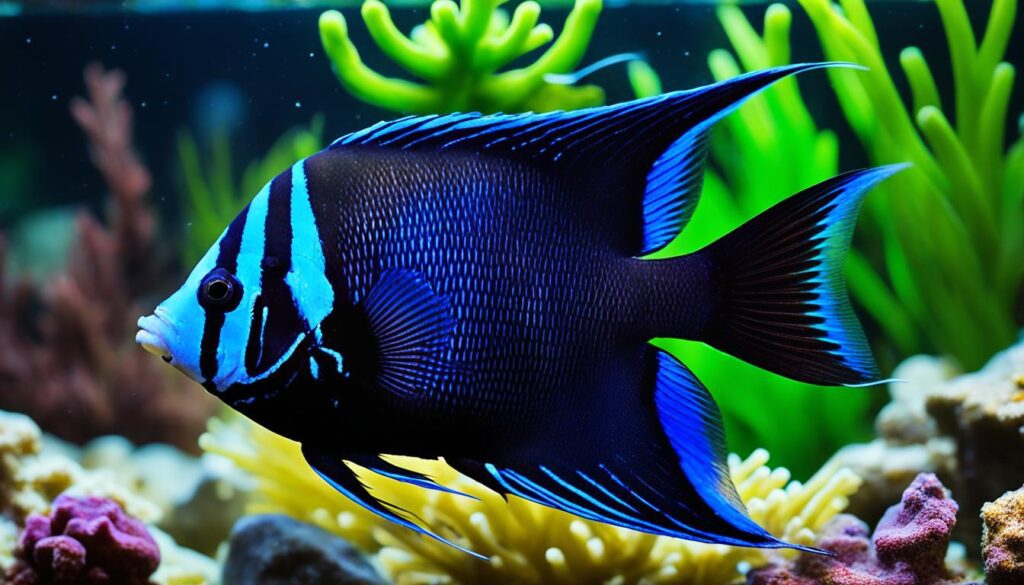
Successfully caring for half-black angelfish means knowing their unique needs. This includes their feeding schedule and how to mix them with other fish because of their semi-aggressive temperament.
Omnivore’s Menu: Feeding Habits and Nutritional Needs
The diet of an angelfish is key to its health. These fish do well on a mix of meat and greens. They enjoy brine shrimp, mysis shrimp, and quality pellets or flakes. It’s good to also give them algae-based foods, reflecting their natural eating habits.
It’s vital to set a feeding schedule. Feed your half-black angelfish two times a day. Offer them enough food they can eat in five minutes. This keeps them from being overfed and helps keep the water clean. Doing so supports their health.
Behavioral Traits: Establishing a Harmonious Aquarium Community
The semi-aggressive temperament of half-black angelfish requires understanding. This helps make a peaceful aquarium. They might act territorial, especially towards similar fish. Choosing the right tank mates is crucial. Go for calm species like Clownfish, Gobies, and Anthias. These choices build a balanced community and reduce aggression towards the angelfish.
Below is a table showing the best conditions for half-black angelfish:
Habitat Condition |
Optimal Range |
|---|---|
Tank Size |
30 gallons minimum |
Water Temperature |
72-78°F |
pH Level |
8.1-8.4 |
Salinity |
1.020-1.025 |
Compatibility |
Good with Clownfish, Gobies, Anthias |
With proper care, feeding, and tank management, your half-black angelfish will flourish. Knowing about their diet, behavior, and which fish they get along with is key to this success.
Ensuring Optimal Health: Tank Setup for Half-Black Angelfish
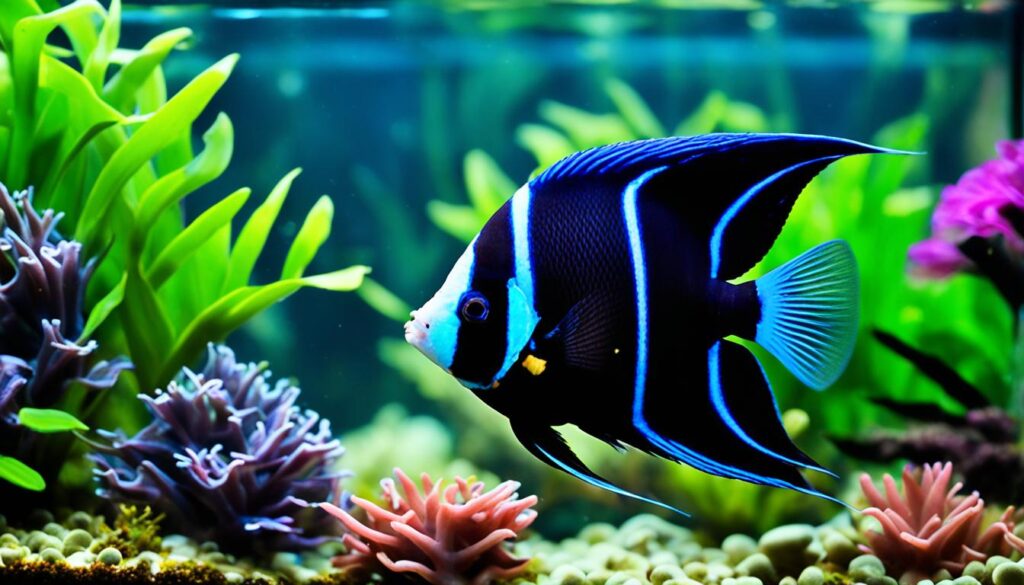
Creating a thriving habitat for Half-Black Angelfish is more than simply adding water and fish. It requires a thoughtful approach. This approach ensures these beautiful fish do well. We’ll explore how landscape design and water quality management are key to keeping them healthy and beautiful.
Landscape Design: The Importance of Plants and Driftwood
Adding plants and driftwood to your tank does more than make it look pretty. These elements recreate the natural home of the Half-Black Angelfish. They provide shelter and peace, reducing stress. This makes the angelfish behave naturally and create safe territories. Here are some great plants and wood for your angelfish tank:
- Amazon Sword: Provides great cover and is simple to care for.
- Anubias: Attaches to driftwood and needs little light.
- Java Fern: A sturdy option that does well with angelfish.
Clean and Balanced: Water Quality and Filtration Considerations
Half-Black Angelfish need very clean water, so filters and water changes are vital. A good filter should clean all the water in the tank many times an hour. It keeps harmful chemicals low and avoids strong currents that stress the fish. Here are the best water conditions:
Parameter |
Ideal Range |
|---|---|
Tank Size |
Minimum 29 gallons (130 liters) |
pH |
6-8 |
Temperature |
25-30°C (78-86°F) |
Along with a good filter, change 20-25% of the water every week. This keeps nitrate levels low and removes pollutants. It also adds fresh minerals that help your fish grow healthy.
Following these steps helps keep your Half-Black Angelfish healthy. It also makes your aquarium a beautiful display for everyone to enjoy.
Half-Black Angelfish: Breeding Techniques and Raising Fry
In my angelfish breeding journey, I’ve developed a near-perfect method. It focuses on selective breeding to highlight the half-black pattern. This trait is often hidden but can be revealed with care. I pay close attention from setting up the environment to watching the eggs develop. Sometimes, I find two females instead of a breeding pair.
If there’s a hatch within 72 hours, I’m on the right track for a successful brood. By 120 hours post-spawn, I remove any bad eggs to keep the rest safe. By 144 hours, the fry get ready for their big swim and first meal. A warm tank, between 78° to 80°F, is crucial. At 168 hours, the fry often move to a smaller, 10-gallon setup. This care routine has led to a thriving angelfish community, some living up to ten years.
Food is a big part of raising healthy angelfish. From brine shrimp to a mix of flake, live, and frozen foods, variety is key. Feeding the fry three to four times a day helps them grow strong. Yet, it’s not all about food. Large, frequent water changes and watching for spawning behaviors help fight off disease. With consistent care, breeding every 7 to 10 days is both enjoyable and rewarding. It brings the unique beauty of the Half-Black Angelfish to many.

